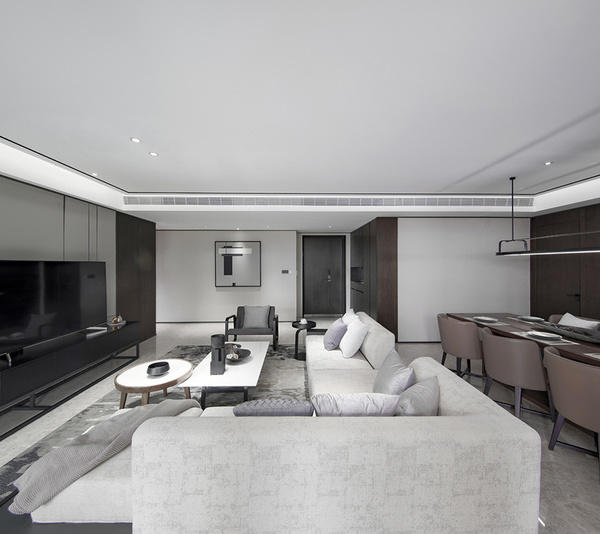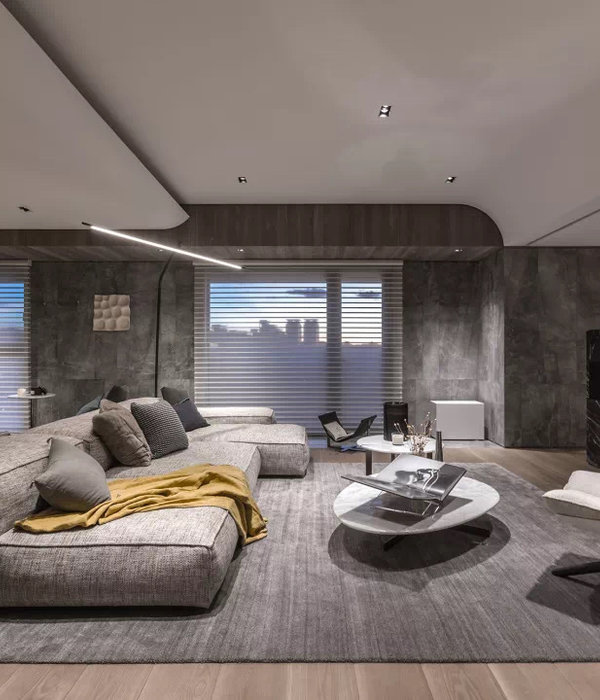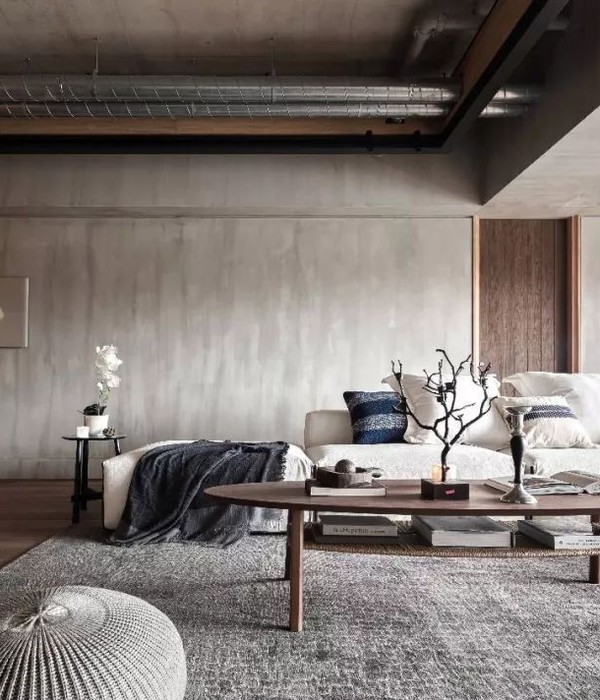该项目位于巴西圣保罗的Ibirapuera公园附近,是一栋建于1971年颇具特色的住宅。改造前的室内空间由于缺乏自然光线而显得昏暗压抑,复杂的隔墙布局,不仅导致了多余的房间和门,更是使整栋住宅缺乏良好的通风。除此之外,建筑侧面距场地边界后退的距离也十分狭小,这就导致了原住宅必须设置很高的边界墙以保证居住者的隐私。改造设计的核心挑战旨在改善以上问题,为底层的家庭生活空间带来理想的自然采光与通风。
The featured house was built in 1971 near to the Ibirapuera Park in São Paulo, Brazil. Due to the lack of access to natural light, it was dark inside. It was compartmentalized and there was an excess of rooms and doors making the spaces isolated and with no ventilation. In addition, the side setbacks were also small and had high boundary walls. A big challenge was to bring light and ventilation to the family’s living spaces on the ground floor.
▼室内概览,overview
改造的主要策略即拆除所有的内墙,为住宅底层营造一个独特且完整的环境。实施该策略的首要难点在于,在拆除隔墙前首先要确定柱子、地基的具体位置,并评估地面的稳定性。因为,在项目之初,设计师所掌握的资料仅仅是一张已经被修改过的简化版平面布局图。
The main proposal was to tear down all the internal walls making the ground floor a unique and integrated environment. The first difficulty was physically locating the pillars, knowing where the foundations were and the stability of the ground since that, from the original construction, we had only a simplified layout plan that had already been modified.
▼入口,entrance
在拆除不必要的装饰并确定柱子的位置后,设计师在建筑中置入了一个全新的结构来支撑二楼,同时拆除了所有的内部隔墙、砖石楼梯,以及楼梯周围的墙体。经过严谨计算的金属梁、柱沿着住宅的核心区域排布,为了加强结构的美感,设计选择将其暴露在空间中,并涂成绿色。创新的是,这个颜色是在社交媒体上投票选出的。
▼轴测图,axonometric drawing
After the demolition and the location of the pillars, we opted for a new structure to support the second floor and eliminate all the walls, in special tearing down the entire masonry staircase and the walls that enclosed it. Metal beams and pillars were calculated and scored on a perimeter in the center of the house. To enhance the structure, we chose to make it visible and painted it in a shade of green. As one more innovation, the color was chosen on social media by open, general vote.
▼面向后院的窗,window facing the backyard
窗口可以滑动打开,the window can be opened by sliding
▼细部,details
住宅内的原窗口被放大,并采用了手工制作的金属窗框。窗口后部通向后院以及院内的小木屋,当滑动门打开,室内空间将得到完全地释放。在平面中央的核心空间中,两扇狭窄的小窗合二为一,形成了如正立面窗口一般的大型窗户。金属框架保证了窗户的安全性,因此原先所有通往入口空间的栅栏都得以被移除。
We enlarged all the windows with frames in handcrafted metalwork. At the back, giving access to a backyard and a shed, a folding door opens, completely releasing the space. In the central room, two narrow windows were merged into a single, wider window as it in the window on the front facade. The frames were intended to provide safety and so we could remove the bars that were previously in all the access spaces to the house.
▼核心空间中两扇狭窄的小窗合二为一形成大窗,two narrow windows were merged into a single large window in the core space, providing a panoramic view of the surrounding environment.
▼细部,details
原来位于楼梯二楼的窄窗被替换为一扇更大的采光窗,窗口由玻璃砖填充,这种设计既能透光又不影响居住者的隐私和安全。楼梯是本项目的亮点,与住宅中所有其他金属结构一样,这部楼梯也是专门为该项目而设计的。它由弯曲的金属板制成,梯段两侧的桁条沿着整个结构延伸,纤细的金属扶手仅在两个点上进行支撑,宛如漂浮一般。为了回应业主对该住宅的主要需求之一 —— 家庭办公空间,设计师在楼梯下侧置入了一个大型书柜,书柜主体的金属结构以及木制书架沿着楼梯空间延伸,直至二楼天花板。
A narrow window that was on the second floor of the original stairs was replaced by a larger light window, filled with glass bricks which could give light without jeopardizing privacy and safety. The ladder is the highlight of the project. In the same shade of green as all the other metal structures in the house and designed especially for the project, it was made of bent sheet metal with two stringers that extend along the entire structure and a handrail that seems to float as it is supported only at two points.A home office space, one of the main resident demands, was designed below the stairs in front of a large bookcase with a metal structure and wooden shelves that extends along the entire height created by the stairs to the ceiling of the second floor.
▼绿色金属框架暴露在空间中,the green metal frame is exposed to the space
▼楼梯是本项目的亮点,the staircase is the highlight of the project
▼楼梯下册的书房,office area under the staircase
▼楼梯细部,details of the staircase
▼俯瞰楼梯,overlooking the staircase
水泥瓷砖地板标志着入口、楼梯和家庭办公空间,并与上方贯穿天花板的金属梁对齐,鳞状拼接的纤皮玉蕊实木地板与水泥瓷砖地板相接,标志出电视室、客厅以及餐厅空间。白色的墙壁进一步反射着从窗户进入室内的光线,使屋内变得更加通透明亮。原始砖墙的一角被刻意暴露在空间中,在整个建筑的材质纹理和色调中发挥了重要作用。
The cement tile floor marks the entrance, staircase and home office space and aligns with the metal beam that passes just above, bordering the tauari wood floor with a fish scale pagination that marks the spaces of the TV room, living room and dinner room. The white walls further reflect the light that enters through the windows. One of them was partially peeled to expose the original structural bricks of the construction playing with the textures and colors throughout the construction.
▼墙面与结构细部,details of the wall and structure
▼地面细部,details of the floor
▼改造后平面图,plan after renovation
▼剖面图,sections
Project name: GAMA HOUSE
firm: Studio ArquitetURAS
Website:Social midia: @studio_arquiteturasE-mail:Localização do Escritório: Rua Barão de Capanema, 343, 12º andar, São Paulo – SP
Year of the conclution : 2022
Área: 160m2
location: Jardim Luzitania, São Paulo – SP
Programa – entrance hall
– living room– TV room– stairs– Home Office– kitchen– Dining room
Lead Architect: Luciana Uras
Midia
photos: Julia Novoa
photographer E-mail:Instagram: @novoajuliaaVideo credits: Julia Novoa (gifs) Luciana Uras (videos)Constrution:CONSTRUCTOR: Bricks Engenharia
{{item.text_origin}}












